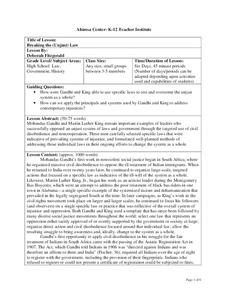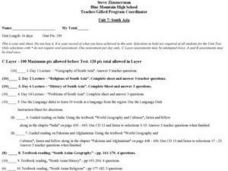Curated OER
The Roots of Ahimsa
Students investigate the philosophy of nonviolence. In this Ghandi lesson, students discover that Gandhi inspired many civil rights leaders with the idea of ahimsa. Students complete venn diagrams, create timelines, and discuss reading...
Curated OER
Mohandas Gandhi: Changing the World One Step at a Time
Students illustrate pages of a book. For this famous historical icon lesson, students are read a story about Mohandas Gandhi, illustrate the pages in small groups, assemble a class book to read to younger students, and act out a scene...
Curated OER
Truth and love by Ghandi and King: Experimenting with Satyagraha
Students research Ghandi's philosophy of Satyagraha. In this Satyagraha instructional activity, students see how Martin Luther King incorporated Ghandi's "truth-force" philosophy into the Black Freedom Movement. They see how this...
Curated OER
Religion in Social Change: What's God Got To Do With It?
Students determine how religion influences social change. In this religion and social change instructional activity, students examine how the religious beliefs of Mohandas Gandhi and Martin Luther King, Jr. were inspirational as they...
Curated OER
Effects of the Stono Rebellion
Fourth graders learn about a slavery rebellion. In this slavery lesson, 4th graders work in groups to review different non-violent ways enslaved Africans protested slavery. Students learn about the Stono Rebellion, read a letter...
Curated OER
Give Peace A Chance: Nonviolence as a valid strategy for social change
Students analyze how people solve conflicts. In this conflict resolution instructional activity, students look at Mahatma Gandhi and Martin Luther King's nonviolence movements. They see the reasoning behind nonviolence and how it works.
Curated OER
The Power of Our Stories
Students compare violence to nonviolence. in this peace lesson plan, students tell stories from their own life that show the difference between violence and nonviolence. They listen to examples of Gandhi and Martin Luther King.
Curated OER
H.D. Thoreau's Philosophy of Government
Students read an essay by H.D. Thoreau as analysis of his philosophy on government. In this Thoreau analysis lesson, students work in groups to paraphrase two of Thoreau's criteria for his beliefs about government. Students write a...
Curated OER
The Way You Dream: Gandhi and King's Visions of Nonviolence
Students read Gandhi and Dr. King's messages about nonviolence and discuss their visions about loving one's enemies. In this nonviolence instructional activity, students read Gandhi's "Ahimsa, or the Way of Nonviolence" and Dr. Martin...
Curated OER
Civil Disobedience Action Plan
Pupils investigate incidences of civil disobedience. In this civil disobedience lesson, students watch a video and read a newspaper article on civil disobedience. Then, in groups, they search a current newspaper for examples of civil...
Curated OER
Tracing the Idea of Civil Disobedience through Thoreau, Gandhi, and King
Students analyze civil disobedience through history studying Thoreau, Gandhi, and Dr. King. For this civil disobedience lesson, students read and analyze excerpts from Thoreau, Gandhi, and Martin Luther King. Students demonstrate their...
Curated OER
The Power of Our Words: Using Language that Promotes Nonviolence
Students solve conflicts through nonviolent means. In this problem resolution lesson, students practice solving problems in different social settings. They try many nonviolent phrases and they create their own solutions.
Curated OER
Ahimsa in Writers Workshop
Students investigate nonviolent lifestyles by researching the life of Gandhi. In this journalism activity, students define the word ahimsa and how important nonviolence is when solving conflicts. Students create a timeline of personal...
Curated OER
Gandhi's Childhood Experience of Truth and Nonviolence
Fourth graders investigate philosophy by researching the life of Mahatma Gandhi. For this historical biography lesson, 4th graders examine the peaceful philosophy of India's most famous resident. Students participate in role-playing...
Curated OER
Gandhi Speaks Through Clothing
Middle schoolers analyze how Gandhi used the way he dressed to communicate with the Indian people. Students understand why Mahatma Gandhi was such an effective leader of the Indian struggle for independence from British colonial rule
Curated OER
Satyagraha, Its Origins and Applications
Tenth graders study the steps and methods taken by Gandhi. In this World History lesson, 10th graders create illustrations to represent these steps. Students write a persuasive essay on these measures taken by Gandhi.
Curated OER
Satyagraha in Daily Life
Eighth graders explore the concept of satyagraha. In this Mohandas Gandhi lesson, 8th graders read a story titled, "Satyagraha," and discuss the application of the Gandhi's method in the world today.
Curated OER
Abolitionists in U.S. History
Students read and discuss excerpts from the writings of Henry David Thoreau, Frederick Douglass and Sarah Parker Redmond. They compare and contrast the views of the three abolitionists concentrating on the experiences and reasons for...
Curated OER
Understanding the Theoretical Basis for Civil Disobedience
Young scholars analyze Henry David Thoreau's 'On the Duty of Civil Disobedience' and Dr. Martin Luther King's "Letter from Birmingham Jail." In this civil disobedience lesson, students read Thoreau's essay and answer 6 questions for the...
Curated OER
Classroom Management Using Gandhian and Kingian Principles of Nonviolence
Tenth graders study the concept of civil disobedience. For this Current Events lesson, 10th graders participate in a survey that nominates students for hard work and exemplifies nonviolence.
Curated OER
Breaking the Unjust Law
Students consider the concept of civil disobedience. In this lesson on changing unjust laws, students use primary sources to understand how Gandhi and King changed the law. Students will then list laws that they feel are unjust and plan...
Curated OER
A Journey to Paradigm Shifts Guided Through the Lives of Gandhi and King
The students read "The 7 Habits of Highly Effective Teens. Through this study the students will learn what paradigms are, and how to distinguish whether the paradigms they have established in their lives are positive or negative. In...
Curated OER
South Asia
Students study South Asia. They complete various activities including answering questions following lectures, researching current events articles, viewing videos of Gandhi, South India, Pakistan, and Nepal. They select activities...
Curated OER
The Art of Nonviolence: Martin Luther King, Jr., Gandhi, and Concepts of Nonviolence in Indian Art
Young scholars make connections between nonviolent ideals and art. In this visual arts lesson, students discuss the successes of the American Civil Rights Movement and discuss Gandhi's influence on the movement. Young scholars then...

























